Understanding the Role of Inflammation in Autism
Autism Spectrum Disorder (ASD) is a multifaceted neurodevelopmental condition characterized by challenges in communication, social interaction, and behavior. Recent scientific research increasingly highlights the critical role that inflammation, particularly neuroinflammation, plays in the pathophysiology of ASD. This article explores emerging insights into the immune dysregulation underpinning ASD, the implications for behavioral therapies such as Applied Behavior Analysis (ABA), and promising avenues for treatment that target inflammatory pathways.
Neuroinflammation as a Hallmark of Autism Spectrum Disorder
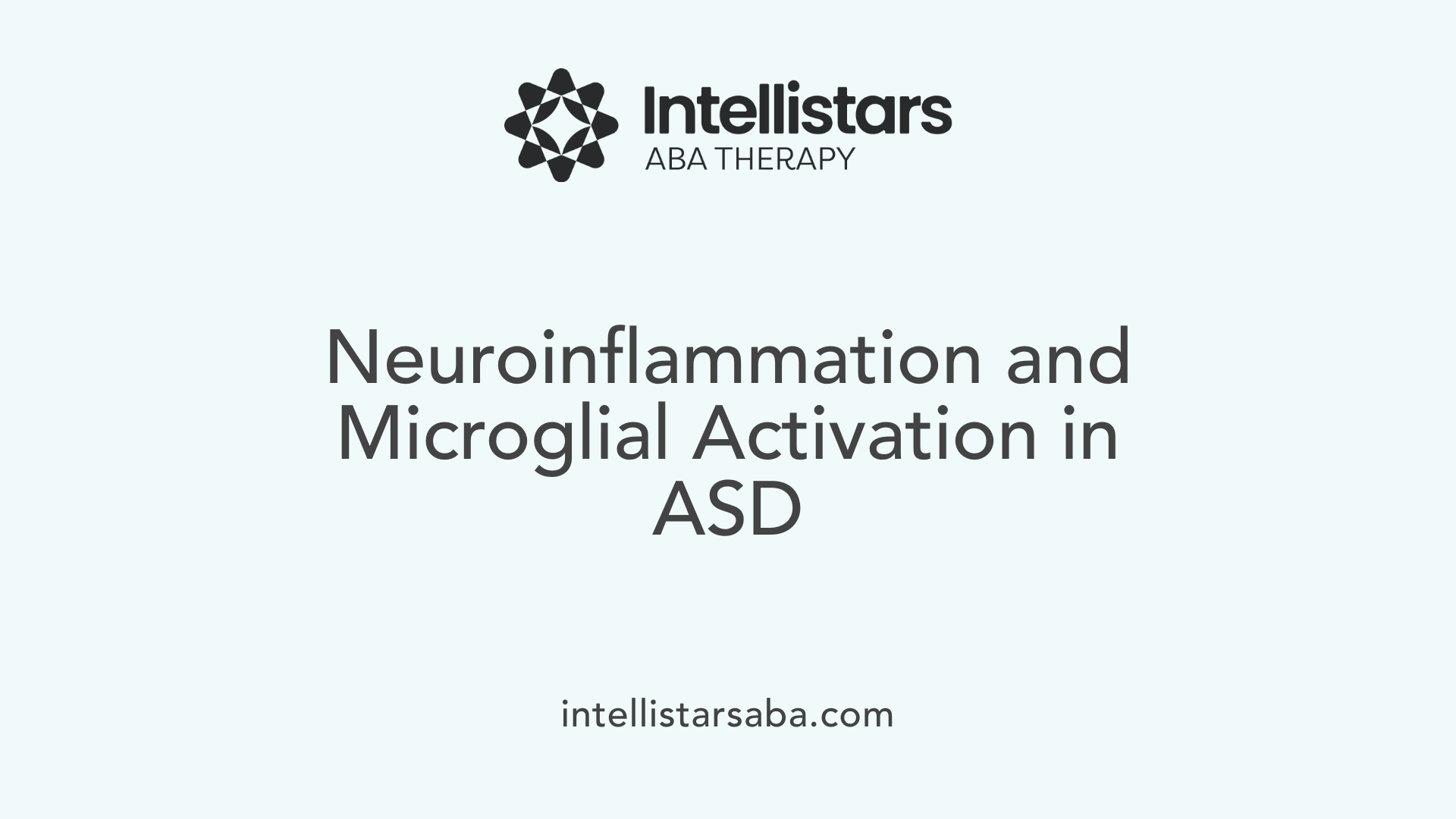
What is neuroinflammation and how is it related to ASD?
Neuroinflammation involves chronic inflammatory reactions occurring within the central nervous system (CNS). It is characterized by the activation of microglial cells—the brain's resident immune cells—and elevated production of pro-inflammatory cytokines.
Neuroinflammation in ASD
In Autism Spectrum Disorder (ASD), neuroinflammation is a prominent feature. Research shows a significant increase in activated microglia within the brains of individuals with ASD. These microglia display changes such as increased density and amoeboid morphology, reflecting a pro-inflammatory state. This ongoing immune activation contributes to CNS derangements that interfere with normal neurodevelopment.
Microglial Activation
Microglial cells can switch between pro-inflammatory and anti-inflammatory phenotypes. In ASD, a dysregulated activation favors chronic inflammation, which may worsen behavioral symptoms. Genetic factors and environmental triggers like maternal immune activation during pregnancy further influence microglial behavior and inflammatory processes.
Pro-inflammatory Cytokines in ASD
Elevated levels of cytokines such as interleukin-1 beta (IL-1β), interleukin-6 (IL-6), interleukin-18 (IL-18), and tumor necrosis factor-alpha (TNF-α) have been consistently found in the blood and cerebrospinal fluid of individuals with ASD. These molecules play central roles in perpetuating neuroinflammation and potentially altering neural circuits related to ASD symptomology.
Central Nervous System Derangements Associated with ASD
The chronic neuroinflammatory state in ASD leads to dysfunction within the CNS, including altered microglial activation and increased expression of immune-related genes like NF-κB pathways. These changes contribute to disruptions in neurodevelopment and synaptic functioning, which are linked to the behavioral and cognitive characteristics of ASD.
| Aspect | Description | Impact on ASD |
|---|---|---|
| Neuroinflammation | Chronic CNS inflammation with activated microglia and cytokine elevation | Influences neurodevelopment and behavioral change |
| Microglial Activation | Increased density and pro-inflammatory phenotype | Exacerbates inflammation and neurodevelopmental disruption |
| Pro-inflammatory Cytokines | Elevated IL-1β, IL-6, IL-18, TNF-α levels in ASD patients | Promote neuroinflammation and ASD-associated CNS abnormalities |
| CNS Derangements | Dysregulated immune gene expression, altered microglial state, and neuroinflammatory signaling | Underpins clinical and behavioral features of ASD |
Inflammasomes and the Inflammatory Cascade in Autism
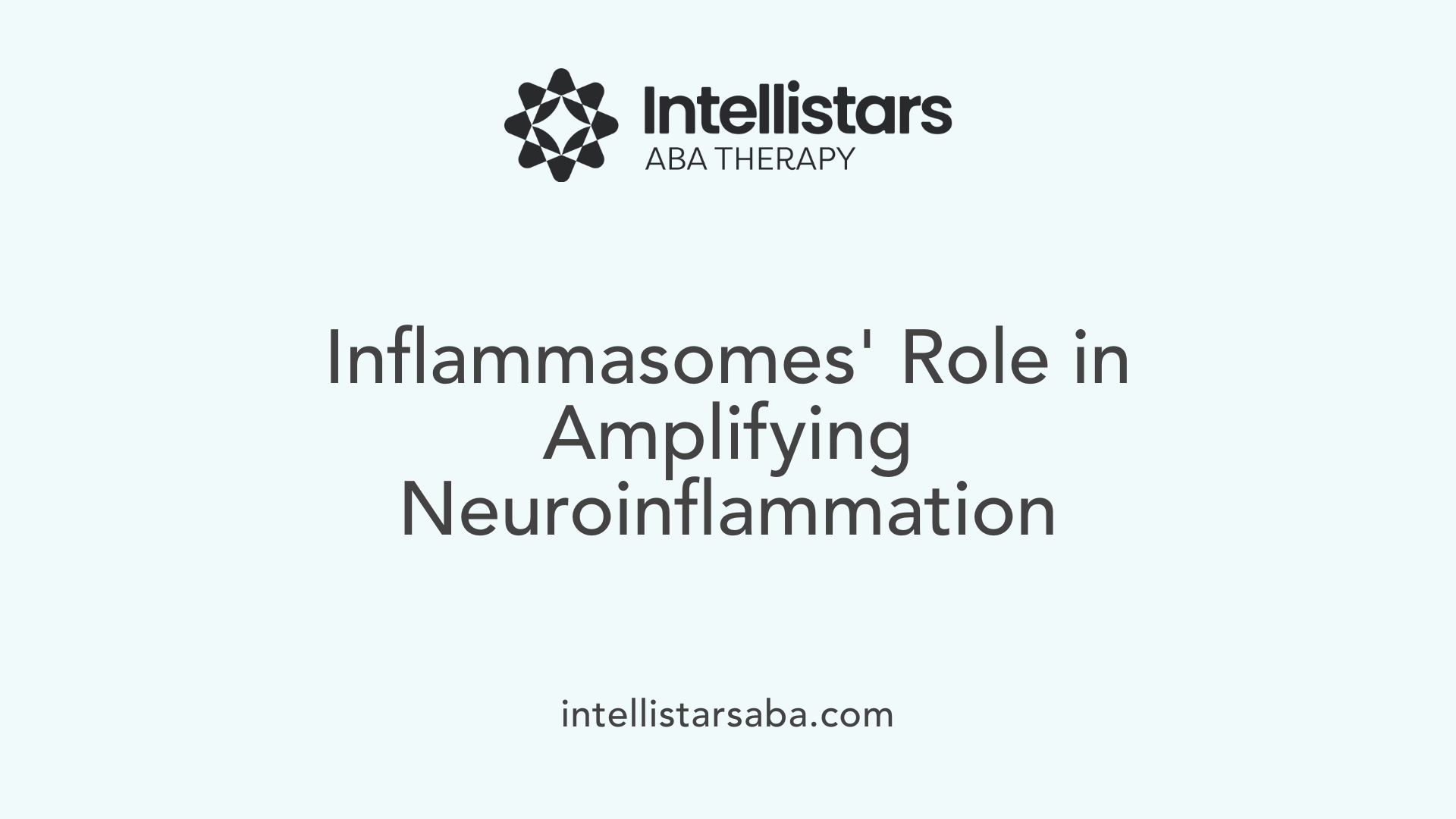
How do inflammasomes influence inflammation in ASD?
Inflammasomes, especially those producing interleukins IL-1β and IL-18, play a pivotal role in amplifying inflammation in Autism Spectrum Disorder (ASD). These protein complexes sense cellular damage or infections and respond by activating inflammatory cytokines, which serve as signaling molecules that promote immune responses.
Role of inflammasomes IL-1β and IL-18
Upon activation, inflammasomes stimulate the maturation and release of IL-1β and IL-18. These cytokines significantly contribute to the neuroinflammatory environment observed in ASD. Their elevated levels have been consistently noted in children with ASD, underscoring their importance in disease pathophysiology.
Chronic inflammation mechanism
The persistent activation of inflammasomes leads to a chronic inflammatory state within the central nervous system. This ongoing inflammation may disrupt neural development and exacerbate autistic behaviors. Microglial cells, the brain's resident immune cells, are influenced by the inflammasome-induced cytokines to maintain a proinflammatory phenotype that sustains neuroinflammation over time.
Cytokine activation pathways
Inflammasome activation initiates a cascade that involves the nuclear factor kappa-light-chain-enhancer of activated B cells (NF-κB) pathway, which further promotes the production of inflammatory mediators. This molecular mechanism amplifies cytokine signaling and reinforces inflammation within neural tissues.
Impact on ASD behavior
The inflammation driven by IL-1β and IL-18 modifies neuronal circuits and synaptic function. This alteration can worsen behavioral symptoms seen in ASD, including social communication deficits and repetitive behaviors. Reducing inflammasome activation is thereby considered a promising therapeutic avenue to mitigate neuroinflammation and improve ASD outcomes.
Elevated Pro-Inflammatory Cytokines and Immune Dysregulation in ASD
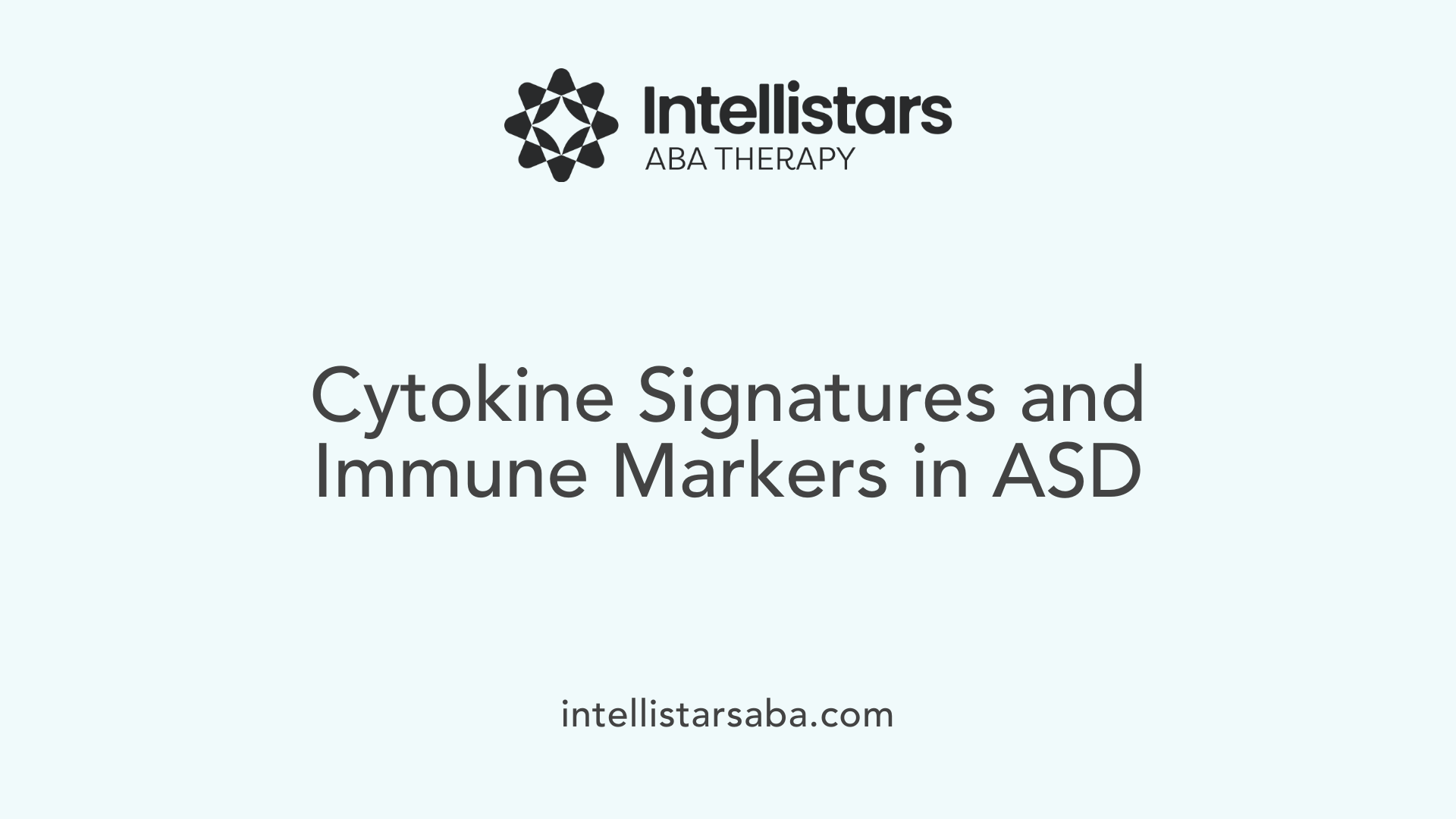
What inflammatory markers are elevated in individuals with ASD?
Research consistently shows that individuals with Autism Spectrum Disorder (ASD) have elevated levels of pro-inflammatory cytokines such as IL-6, IL-1β, IL-18, and TNF-α. These cytokines play a significant role in the chronic neuroinflammation observed in ASD, potentially exacerbating behavioral symptoms.
Immune profile in ASD patients
Beyond these cytokines, additional immune markers including CD244 (natural killer cell receptor 2B4), FLT3LG (Fms-related tyrosine kinase 3 ligand), and TNFSF10 (tumor necrosis factor-related apoptosis-inducing ligand) are found at increased levels in individuals with ASD. These markers indicate an activated immune state with pro-inflammatory and immune-activating effects that may contribute to the disorder’s pathology.
Biomarkers associated with ASD
Studies reveal some biomarkers potentially linked to the risk of ASD, such as decreased IL-7, which might have a protective role, and increased inflammatory enzymes like MMP10 and CASP8, possibly reflecting downstream effects of ASD-related immune abnormalities. Furthermore, anti-inflammatory cytokine IL-37 shows higher gene expression but its protein levels decrease after vitamin D supplementation, which correlates with behavioral improvements.
Immune activation markers in cerebrospinal fluid
The cerebrospinal fluid (CSF) of ASD patients contains elevated cytokines including TNF-α, IL-4, IL-21, IL-31, BAFF, and APRIL. This finding supports the presence of neuroinflammation and widespread immune dysregulation in the central nervous system of those with ASD. Elevated microglial activation—immune cells within the brain—is another hallmark, reinforcing the role of immune system imbalance in ASD.
| Marker | Role/Effect | Relevance to ASD |
|---|---|---|
| IL-6, IL-1β, IL-18 | Pro-inflammatory cytokines | Elevated, contribute to neuroinflammation and symptoms |
| TNF-α | Pro-inflammatory cytokine | Elevated, linked to ASD pathology |
| CD244, FLT3LG | Immune activation markers | Increased, indicate immune dysregulation |
| IL-7 | Potential protective cytokine | Decreased, higher deficiency risk |
| IL-37 | Anti-inflammatory cytokine | Elevated expression; modulated by vitamin D treatment |
| CSF Cytokines | Neuroinflammation indicators | Elevated in ASD, demonstrate CNS inflammation |
Genetic and Molecular Mechanisms Underlying Inflammation in Autism
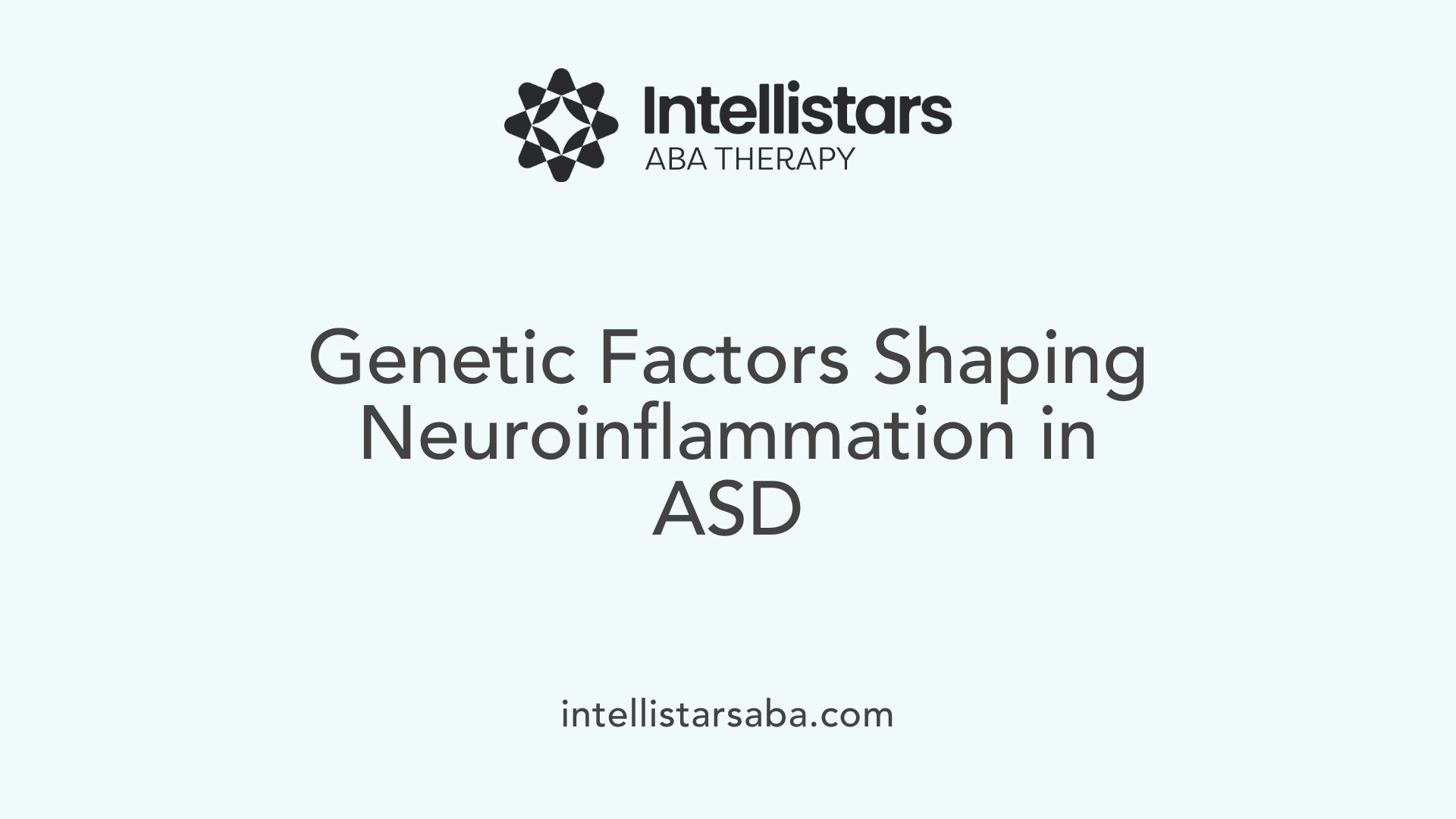
What genetic and molecular factors contribute to inflammation in ASD?
Genetic variants play a crucial role in triggering inflammation linked to autism spectrum disorder (ASD). Particularly, mutations in the TSC1 and TSC2 genes, associated with Tuberous Sclerosis Complex, are connected to immune dysregulation and neuroinflammation observed in ASD. These gene variants may influence the activation and function of immune cells such as microglia, which are central to brain inflammation.
At the molecular level, activation of the NF-κB signaling pathway is fundamental to the inflammation process in ASD. NF-κB induces the expression of multiple pro-inflammatory cytokines and mediators, including IL-1β, IL-6, and TNF-α, which perpetuate neuroinflammation and contribute to the chronic inflammatory state seen in ASD brains.
In addition to NF-κB, other molecular players such as inflammasomes (e.g., IL-1β and IL-18) amplify inflammatory responses. Genetic studies reveal elevated levels of inflammatory and immune-related proteins, including SULT1A1, CD244, CD5, FLT3LG, and TNFSF10, which are positively correlated with ASD risk and point to immune activation pathways influencing disease development.
Upregulation of genes linked to immune response and inflammation pathways—including NF-κB, IL1R1, and IL6—has been demonstrated in postmortem ASD brain tissues. These findings emphasize a genetic and molecular network that sustains inflammation and potentially disrupts neurodevelopment.
Together, these genetic variants and molecular mechanisms orchestrate the inflammatory environment in ASD, highlighting potential targets for therapeutic intervention focused on modulating immune and inflammatory pathways to improve clinical outcomes.
Maternal Immune Activation: Prenatal Inflammation and ASD Risk

How does maternal immune activation affect ASD risk in offspring?
Maternal immune activation (MIA) during pregnancy, characterized by elevated inflammation and immune system responses, has been linked to an increased risk of Autism Spectrum Disorder (ASD) in offspring. When the mother's immune system is activated, it can trigger a cascade of inflammatory cytokines that cross the placental barrier, potentially disrupting fetal brain development.
Effects of immune activation on the fetal brain
This prenatal immune activation affects the fetal brain by altering neurodevelopmental processes. Specifically, increased cytokine production can lead to changes in microglial cells—the brain's resident immune cells—causing them to adopt an activated, often pro-inflammatory state. This dysregulated microglial activation can influence synaptic pruning and neural circuit formation, critical processes during brain development.
Evidence from animal models
Animal studies have provided robust evidence supporting the link between maternal immune activation and ASD-like behaviors in offspring. In these models, pregnant animals exposed to immune challenges exhibit higher levels of pro-inflammatory cytokines and changes in microglial morphology in their offspring. These neuroimmune alterations correlate with behavioral abnormalities that resemble core features of ASD, such as social deficits and repetitive behaviors.
Connection to ASD behaviors
The prenatal environment shaped by maternal immune activation contributes significantly to the etiology of ASD by promoting chronic neuroinflammation and immune dysregulation in the developing brain. This process may underlie the emergence of ASD-related behaviors observed later in life, highlighting the pivotal role of prenatal inflammation in determining neurodevelopmental outcomes.
In summary, maternal immune activation during pregnancy induces inflammatory changes that impact fetal brain development, increasing the risk of ASD in offspring. Animal models substantiate these findings by demonstrating neuroimmune disturbances and behavioral defects following prenatal immune challenges.
The Gut-Brain Axis: Microbiota’s Role in ASD and Neuroinflammation
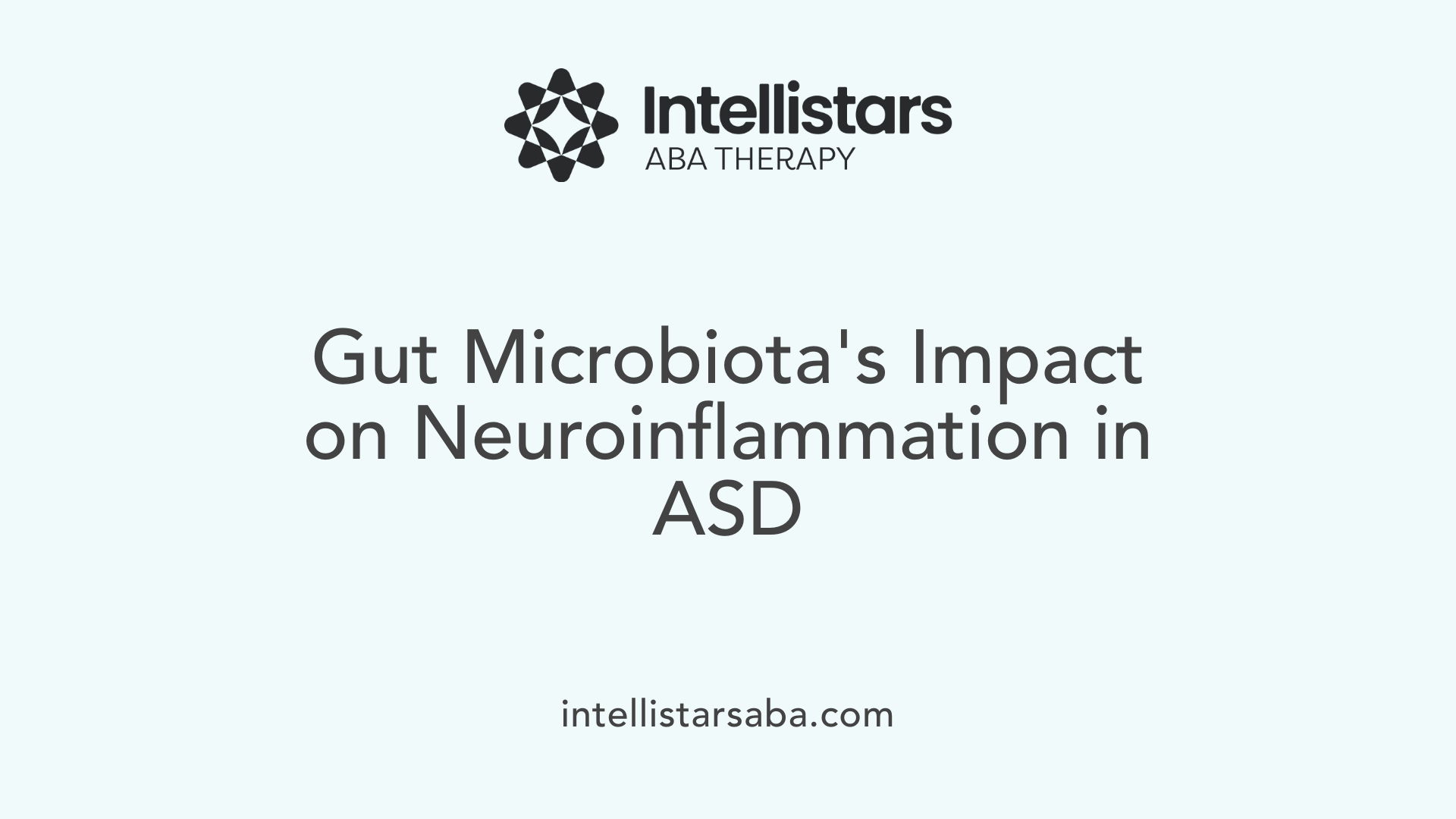
Understanding the Microbiota-Gut-Brain Axis in ASD
The microbiota-gut-brain axis represents an intricate communication network between the gut microbiome, the immune system, and the central nervous system. In Autism Spectrum Disorder (ASD), abnormalities within this axis have emerged as an important focus of study, revealing how gut microbial communities may influence neuroinflammation and neurodevelopment.
Gut Microbiome Abnormalities in ASD
Research indicates that individuals with ASD often exhibit altered gut microbiomes compared to neurotypical peers. These abnormalities can lead to dysregulated immune responses, which exacerbate neuroinflammatory pathways implicated in ASD pathogenesis. Elevated circulating serotonin levels in ASD, linked to altered gut microbiota, underscore this connection between the gastrointestinal system and brain function.
Immune Modulation by the Microbiome
The gut microbiome modulates immune responses through production of metabolites and interaction with intestinal immune cells. Changes in microbial composition can shift the balance of pro- and anti-inflammatory cytokines affecting systemic and neuroinflammation. Studies show that microbiota alterations are associated with increased secretion of pro-inflammatory cytokines like IL-6 and TNF-α, both observed at higher levels in children with ASD.
Effects of Microbiome Interventions on ASD
Emerging research explores therapeutic opportunities through microbial manipulations. Fecal microbiota transplant (FMT) and other microbiome-targeted interventions in animal models have demonstrated improved behavioral symptoms and restored immune function. These findings suggest that correcting gut dysbiosis may help reduce neuroinflammation and ameliorate ASD-associated behaviors, although further clinical research is necessary to establish efficacy and safety.
| Aspect | Observations in ASD | Implications |
|---|---|---|
| Microbiota Composition | Altered gut bacteria balance | Influence on immune signaling and neurodevelopment |
| Immune Cytokine Changes | Increased pro-inflammatory cytokines (IL-6, TNF-α) | Exacerbation of neuroinflammation affecting behavior |
| Therapeutic Interventions | Microbiome restoration via FMT improves symptoms | Potential reduction of inflammation and behavioral improvements |
This growing evidence positions the microbiota-gut-brain axis as a critical factor in ASD, with immune modulation by the gut microbiome contributing to neuroinflammatory processes. Ongoing research aims to harness this relationship for innovative treatments targeting inflammation and behavioral outcomes in ASD.
Neuroactive Metabolite Pathways: Tryptophan Metabolism in ASD
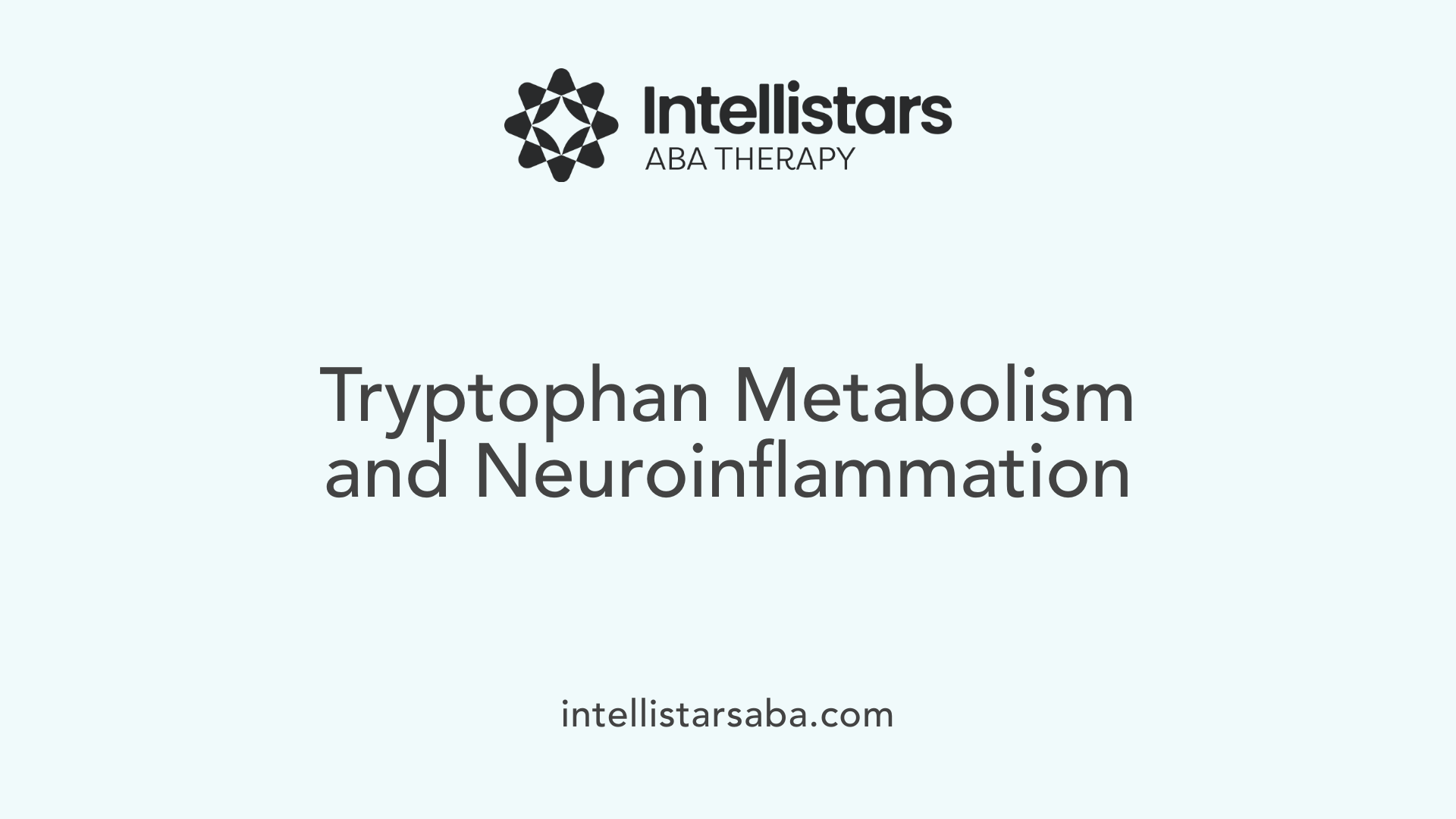
What are the kynurenine pathway metabolites and their roles?
Tryptophan metabolism through the kynurenine pathway produces several important neuroactive metabolites. Two prominent ones are kynurenic acid and quinolinic acid. Kynurenic acid acts as a neuroprotective agent by blocking excitotoxicity, while quinolinic acid is neurotoxic, promoting inflammation and neuronal damage.
How do neuroprotective and neurotoxic metabolites influence ASD?
In Autism Spectrum Disorder (ASD), an imbalance between neuroprotective and neurotoxic metabolites can affect brain development and function. Elevations in quinolinic acid levels, which trigger inflammation, have been observed, potentially contributing to the chronic neuroinflammation often present in ASD. Conversely, lower levels of kynurenic acid might reduce neuroprotection, exacerbating neurological symptoms.
What alterations in tryptophan metabolism are noted in ASD?
Research indicates that individuals with ASD show disruptions in the kynurenine pathway, with abnormal concentrations of metabolites. This shift could underlie some neurodevelopmental and behavioral abnormalities due to increased neurotoxicity and inflammation.
How does serotonin relate to gut microbiome and immune dysregulation in ASD?
ASD is associated with elevated circulating serotonin levels. This may be linked to gut microbiome imbalances, which influence serotonin production and immune system behavior. The serotonin system's dysregulation integrates with immune responses, contributing to ASD pathophysiology through neuroimmune interactions.
These insights position tryptophan metabolism, especially via the kynurenine pathway, as a crucial factor in understanding and potentially targeting neuroinflammatory mechanisms contributing to ASD.
Emerging Therapeutic Targets: Inflammation and Immune Modulation in ASD
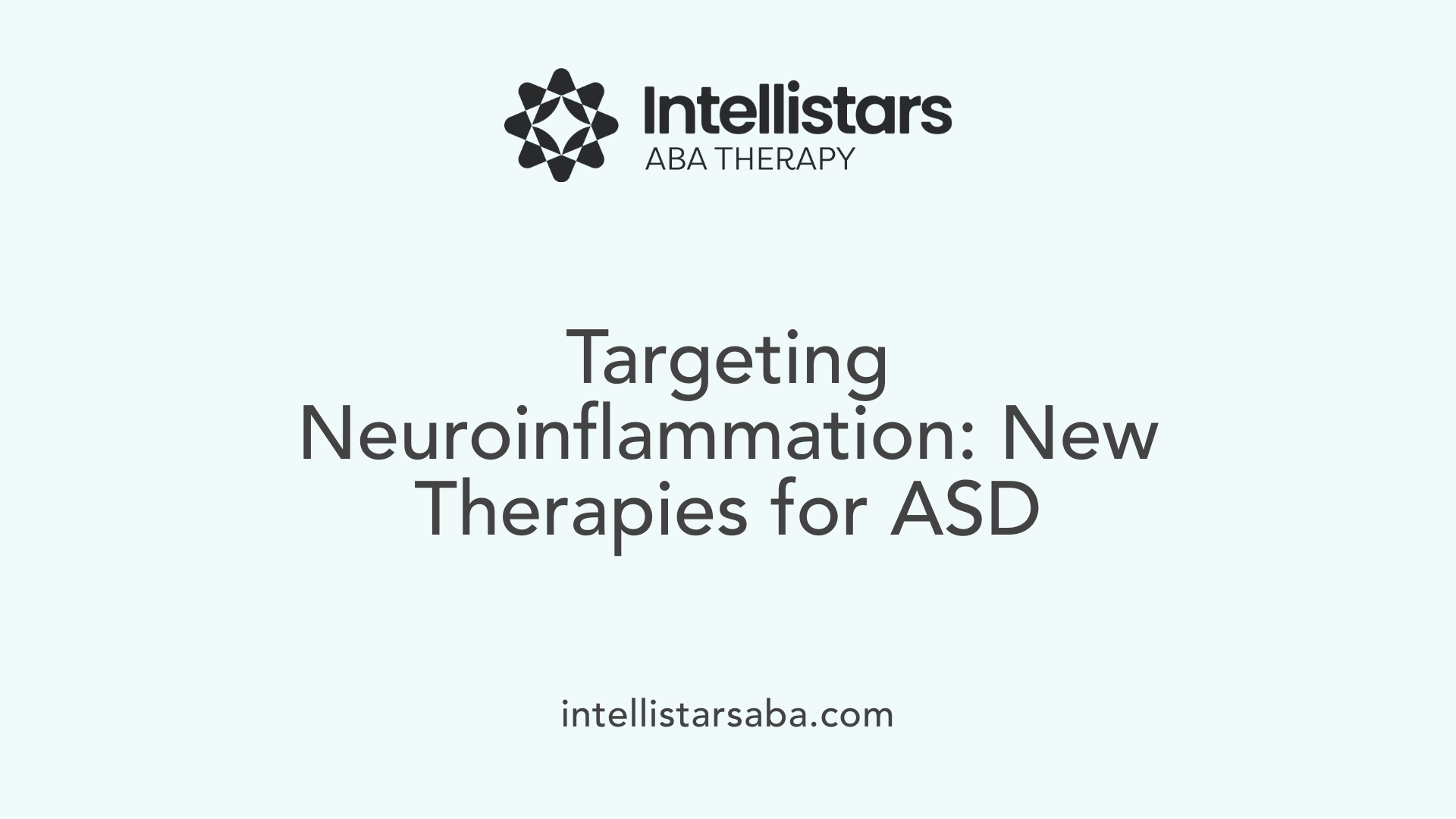
Anti-Inflammatory Treatments in ASD
Recent studies highlight the contribution of neuroinflammation and immune dysregulation to the pathology of Autism Spectrum Disorder (ASD). This has spurred interest in anti-inflammatory treatments as a promising strategy to alleviate symptoms. Agents such as corticosteroids, inflammasome inhibitors like colchicine and anakinra, and cyclooxygenase-2 (COX-2) inhibitors (for example, celecoxib) have demonstrated potential in reducing pro-inflammatory cytokines and improving behavioral outcomes. These treatments aim to dampen chronic inflammation, particularly targeting elevated cytokines such as IL-1β, IL-6, and TNF-α that are consistently found in children with ASD.
Immunomodulatory Therapies and Novel Approaches
Immunomodulatory therapies are expanding beyond traditional anti-inflammatory drugs. Treatments employing intravenous immunoglobulin (IVIg), B-cell targeted monoclonal antibodies like rituximab, and IL-6 receptor blockade with tocilizumab are under investigation for their capacity to recalibrate immune responses. These therapies could help address the aberrant cytokine profiles and immune activation seen in ASD, including imbalances in pro- and anti-inflammatory factors. Nutraceutical supplements with antioxidant and anti-inflammatory properties also offer complementary approaches to modulate neuroinflammation safely.
Role of mTOR Inhibitors and JAK/Th17 Pathway Blockade
Genetic and molecular analyses reveal dysregulation of signaling pathways such as PI3K/Akt/mTOR and JAK/Th17 in subsets of ASD patients. Pharmacological inhibition using mTOR inhibitors like rapamycin has shown promise in preclinical models by potentially normalizing abnormal neurodevelopment. Similarly, selective inhibitors targeting the JAK/Th17 inflammatory pathway may reduce T-cell mediated inflammation implicated in ASD pathology. These targeted therapies highlight the potential for precision medicine tailored to an individual's molecular and immune profile.
Personalized Medicine in ASD Therapy
Given the heterogeneity of ASD and its underlying immune dysfunction, personalized treatment strategies are essential. Careful patient selection based on immune profiling—including cytokine levels, gene variants, and neuroinflammatory markers—can help optimize therapeutic efficacy. Recognizing distinct inflammatory endophenotypes may enable clinicians to better match patients with specific immune modulatory or anti-inflammatory interventions, thereby enhancing clinical outcomes and potentially mitigating behavioral symptoms linked to persistent neuroinflammation.
Vitamin D and Its Immunomodulatory Role in Autism
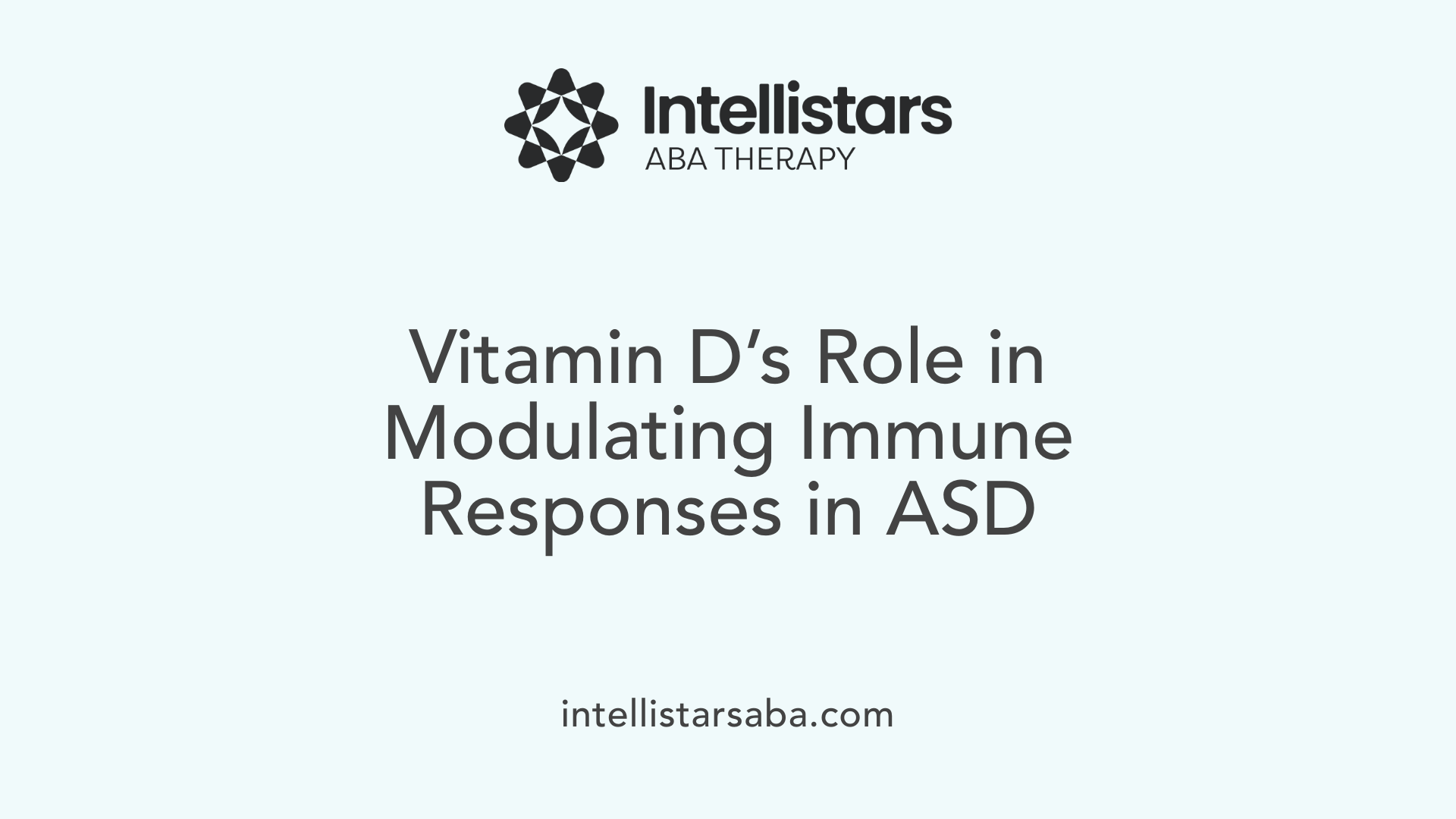
Serum Vitamin D Deficiency in ASD
Children with Autism Spectrum Disorder (ASD) often exhibit lower serum levels of 25-hydroxyvitamin D [25(OH)D]. This deficiency is considered a significant risk factor for ASD, as vitamin D plays essential roles in brain and central nervous system development. Given these low levels, vitamin D status in children with ASD is an important area of research for potential therapeutic strategies.
Immune and Anti-Inflammatory Effects of Vitamin D
Vitamin D is known for its immune-modulating and anti-inflammatory properties. It can reduce the production of pro-inflammatory cytokines, playing a regulatory role in the immune system. Specifically, vitamin D impacts inflammatory pathways implicated in ASD, helping to balance immune responses that might otherwise exacerbate neuroinflammation and behavioral symptoms.
Impact on Cytokines TNF-α and IL-37
Studies have demonstrated that vitamin D supplementation in children with ASD leads to a rise in serum 25(OH)D levels concurrently with a significant decrease in the pro-inflammatory cytokine tumor necrosis factor-alpha (TNF-α) and the anti-inflammatory cytokine interleukin-37 (IL-37). Elevated TNF-α is linked to ASD pathology, while IL-37 gene expression may reflect immune dysregulation. Reducing TNF-α is vital since it contributes to neuroinflammation, and regulating IL-37 may help modulate immune responses.
Behavioral Improvements with Vitamin D Supplementation
Notably, vitamin D supplementation correlates with a significant decrease in scores on the Real Life Rating Scale (RLRS), indicating behavioral improvements in children with ASD. These findings suggest that the modulation of inflammatory cytokines by vitamin D might underlie the observed enhancement in behavioral symptoms, supporting the therapeutic potential of vitamin D as an adjunct in managing ASD.
This growing body of evidence reinforces the hypothesis that vitamin D can influence neuroimmune pathways in ASD and highlights the promise of vitamin D supplementation in improving both inflammation and behavioral outcomes in affected individuals.
Nutraceutical Approaches to Attenuate Neuroinflammation in ASD
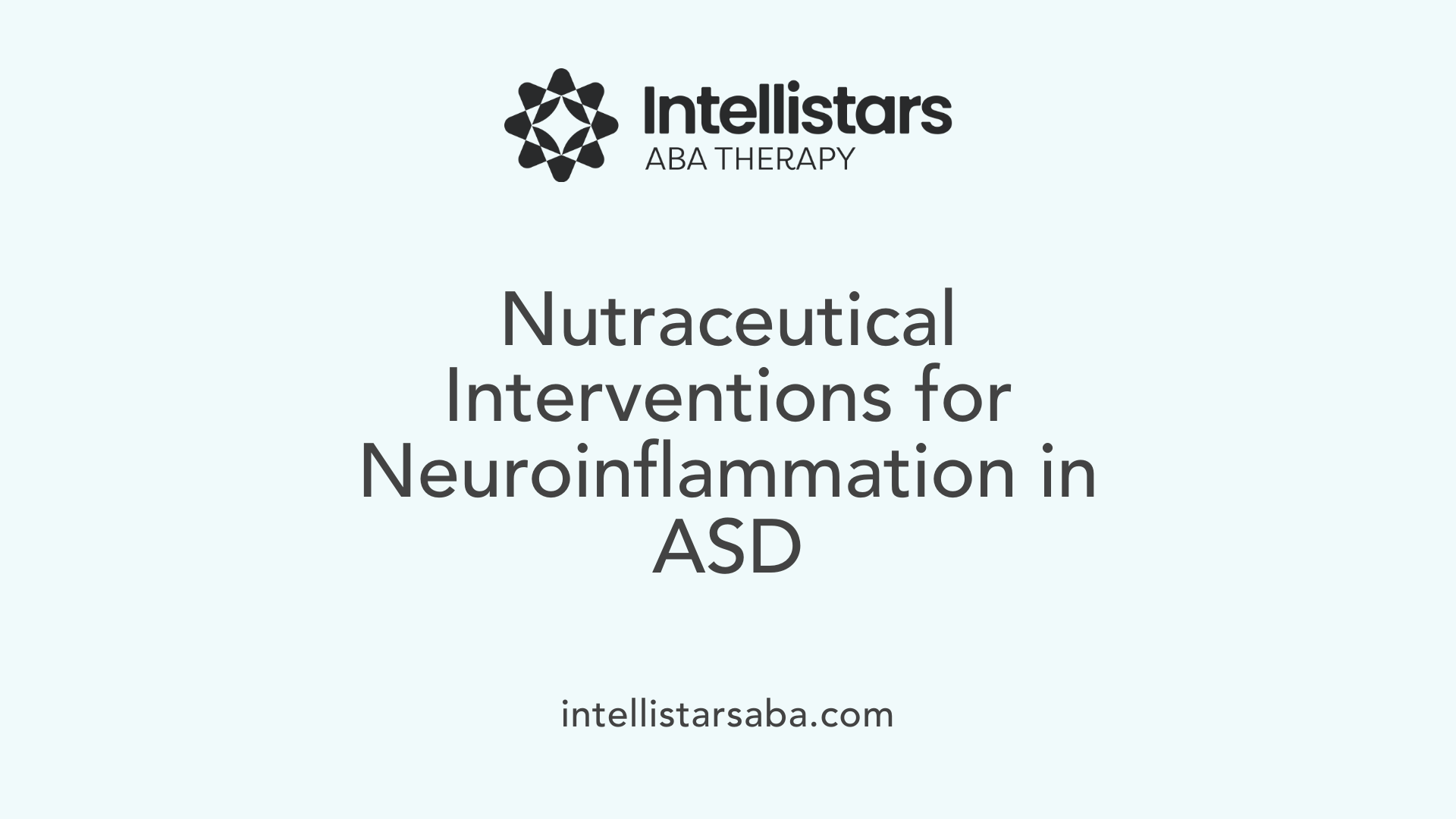
What antioxidant and anti-inflammatory supplements show promise for ASD?
Antioxidant and anti-inflammatory nutraceuticals have gained attention as potential supports for individuals with Autism Spectrum Disorder (ASD). These supplements aim to reduce neuroinflammation—a hallmark of ASD characterized by activated microglia and elevated pro-inflammatory cytokines like IL-6 and TNF-α. Commonly studied compounds include omega-3 fatty acids, vitamin D, curcumin, and N-acetylcysteine, which may modulate immune responses and oxidative stress.
What evidence do preclinical and clinical trials provide?
Preclinical studies demonstrate that nutraceutical compounds can reduce markers of neuroinflammation in animal models mimicking ASD-like behaviors. Clinical trials, although limited, have noted improvements in inflammatory profiles and behavioral parameters. For example, vitamin D supplementation increases serum 25(OH)D levels and lowers pro-inflammatory cytokines such as TNF-α and IL-37, correlating with behavioral improvements measured by scales like the Real Life Rating Scale (RLRS).
How might these supplements benefit behavioral symptoms?
Modulation of inflammation by nutraceuticals appears to underlie observed behavioral improvements in ASD patients. By attenuating neuroinflammation and oxidative stress, these compounds may support better neurodevelopmental outcomes and reduce behavioral symptoms such as social deficits and repetitive behaviors. The immune-modulating effects of vitamin D are a notable example illustrating this connection.
Why are nutraceutical approaches important given current treatments?
Currently, there is no standardized treatment targeting neuroinflammation specifically in ASD. Nutraceuticals represent a promising, relatively low-risk approach to complement existing therapies, addressing immune dysfunction and inflammation. Their development may help fill gaps in treatment options, especially as research advances toward precise immune-based interventions tailored to individual patient profiles.
The Role of Microglial Phenotypes in ASD Neurodevelopment
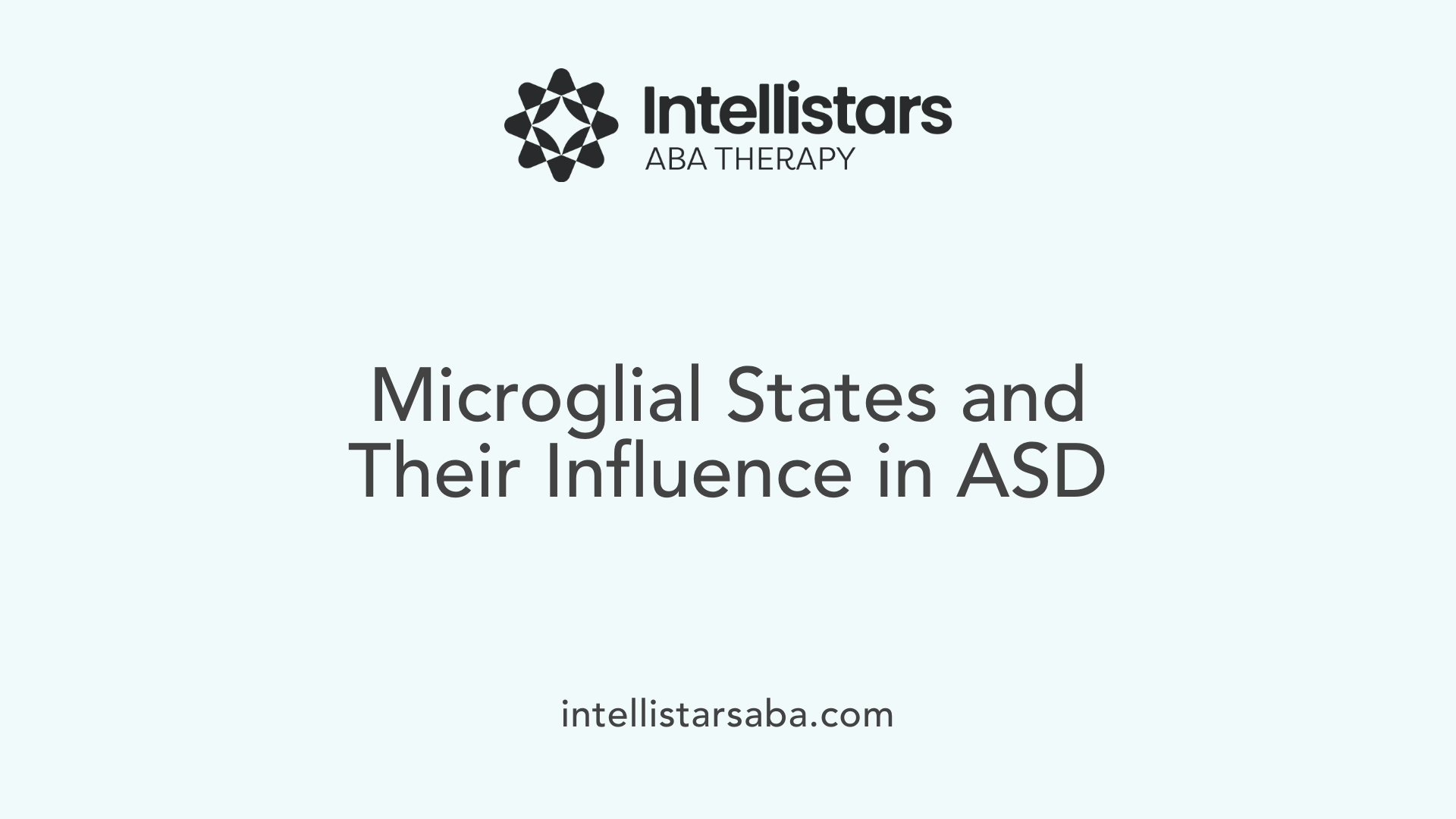
What are microglial pro-inflammatory vs anti-inflammatory states?
Microglial cells are the resident immune cells of the brain that can adopt different functional states. In Autism Spectrum Disorder (ASD), these cells often shift between a pro-inflammatory (activated) phenotype characterized by the release of cytokines like IL-1β and TNF-α, and an anti-inflammatory (restorative) phenotype that supports tissue repair and neural homeostasis.
How do microglial phenotypes influence neuronal circuits?
Pro-inflammatory microglial activation can disrupt normal neurodevelopment by altering synaptic pruning and neuronal connectivity. This aberrant activity may lead to the abnormal formation and function of neural circuits involved in behavior and cognition, which are commonly impaired in ASD.
What are the consequences of chronic neuroinflammation?
Persistent pro-inflammatory microglial activation promotes chronic neuroinflammation, leading to sustained neural damage. Chronic inflammation can exacerbate autistic behaviors and may contribute to long-term alterations in brain structure and function. Dysregulated microglial activity is thus a hallmark of neuroinflammation observed in ASD brains.
What are the implications for therapeutic targeting?
Targeting microglial activation states offers promising therapeutic potential. Treatments aimed at shifting microglia from a pro-inflammatory to an anti-inflammatory phenotype could reduce neuroinflammation and its behavioral consequences. This strategy supports the development of personalized therapies that modulate immune responses in ASD, including anti-inflammatory compounds and immunomodulators currently under investigation.
Inflammation-Associated Lipid Metabolism in Autism
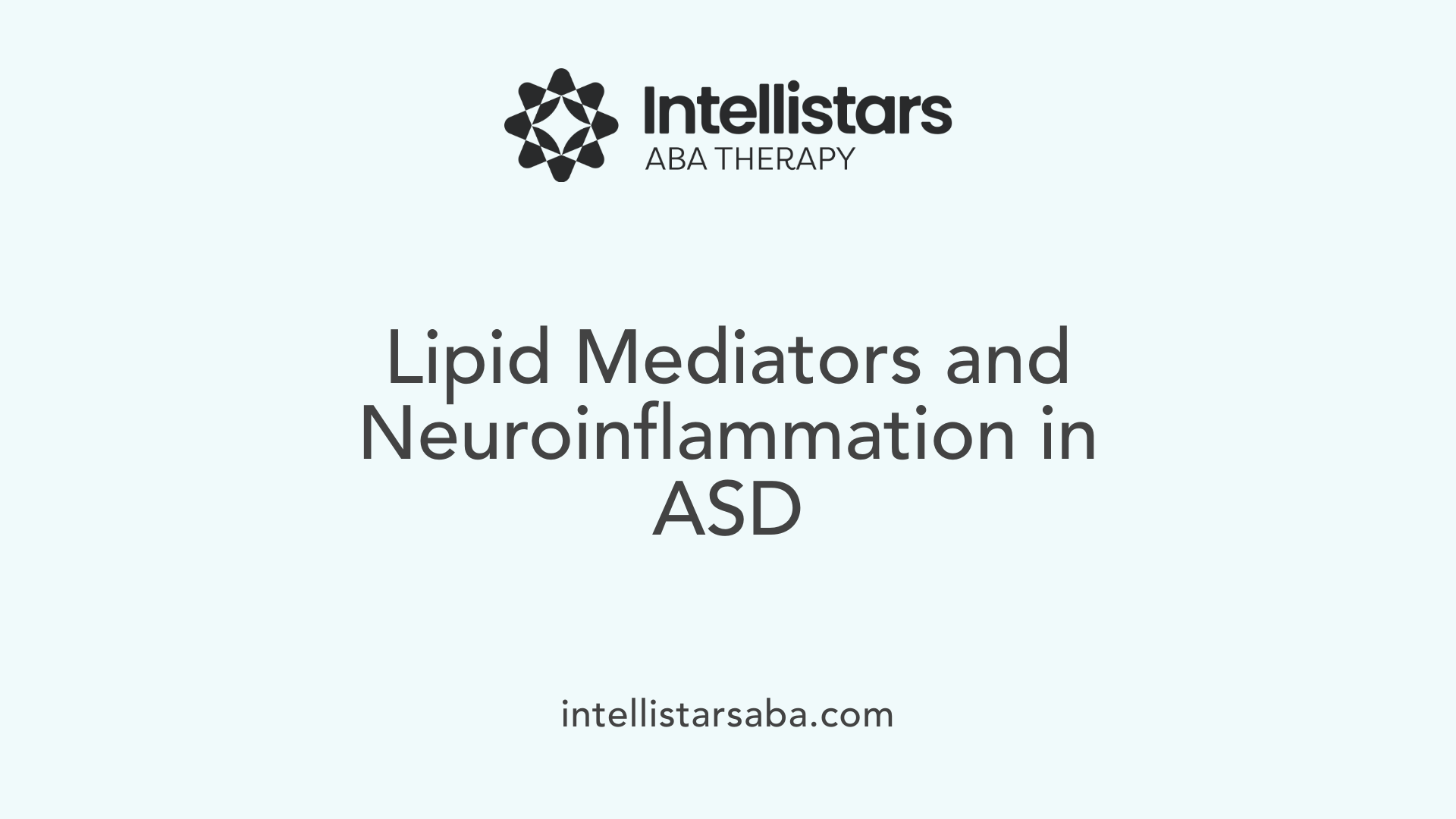
What Role Do COX1/2 Enzymes Play in Autism?
Cyclooxygenase enzymes COX-1 and COX-2 are critical in the metabolism of lipids that regulate inflammation. In the context of autism spectrum disorder (ASD), increased COX-2 activity has been documented, suggesting an active involvement of these enzymes in neuroinflammatory processes associated with ASD. COX enzymes catalyze the conversion of arachidonic acid to prostaglandins, which are lipid compounds influencing immune responses and neurodevelopment.
How Do Prostaglandins Such as PGE2 Influence Neurodevelopment in ASD?
Prostaglandins, particularly prostaglandin E2 (PGE2), act as mediators of inflammation and have notable effects on the brain's development and function. Altered levels of prostaglandins may modulate neuronal signaling pathways, impacting brain development and possibly contributing to behavioral symptoms observed in ASD. Dysregulation in these lipid mediators may exacerbate neuroinflammation, influencing symptom severity.
What Is Known About COX-2 Inhibitors Like Celecoxib in ASD Treatment?
COX-2 inhibitors such as celecoxib have shown promise in reducing inflammation by inhibiting the COX-2 enzyme's activity. Clinical and preclinical studies indicate that celecoxib may alleviate behavioral symptoms in individuals with ASD by dampening neuroinflammation. These inhibitors represent a potential targeted therapeutic approach aiming to modulate inflammatory pathways linked to autism pathology.
How Does Lipid Metabolism Affect Neurodevelopment and Behavior in ASD?
Alterations in lipid metabolism, mediated through enzymes like COX-1 and COX-2 and their products, prostaglandins, play a significant role in neurodevelopmental processes. Abnormal lipid signaling can lead to excessive or chronic neuroinflammation, influencing synaptic connectivity and brain plasticity. This disruption may contribute to the emergence and persistence of behavioral symptoms characteristic of ASD.
| Aspect | Role in ASD | Therapeutic Implications |
|---|---|---|
| COX1/2 Enzymes | Catalyze lipid mediators involved in inflammation | Target for reducing neuroinflammatory responses |
| Prostaglandins (e.g., PGE2) | Influence neurodevelopment and immune responses | Modulation may affect behavior and brain function |
| COX-2 Inhibitors (Celecoxib) | Reduce COX-2 mediated inflammation | Potential to improve behavioral symptoms |
| Lipid Metabolism | Modulates neuroinflammatory environment and neurodevelopment | Disruption linked to ASD pathology |
Inflammation-Driven Changes in Signaling Pathways and Neurodevelopment

How does the PI3K/Akt/mTOR pathway relate to neurodevelopment and ASD?
The PI3K/Akt/mTOR signaling pathway is critical for proper neurodevelopment, regulating cell growth, proliferation, and synaptic plasticity. Dysregulation of this pathway has been linked to Autism Spectrum Disorder (ASD), implicating it as a crucial conduit where inflammation and neurodevelopment intersect.
What genetic variants affect this signaling pathway in ASD?
Certain genetic variants associated with ASD influence components of the PI3K/Akt/mTOR pathway, potentially exacerbating immune-inflammatory responses that contribute to atypical brain development. These genetic alterations may facilitate chronic neuroinflammation by modulating immune cell signaling and cytokine production.
Can rapamycin serve as a treatment targeting this pathway?
Rapamycin, an mTOR inhibitor, has emerged as a prospective treatment in ASD cases involving hyperactivation of the PI3K/Akt/mTOR pathway. By dampening mTOR signaling, rapamycin may reduce neuroinflammation and normalize affected neurodevelopmental processes, offering therapeutic benefits in selected individuals.
How does immune-inflammatory crosstalk affect ASD pathology?
Immune-inflammatory crosstalk involving the activation of inflammatory cytokines and microglial cells influence the PI3K/Akt/mTOR pathway, resulting in altered neurodevelopment. This bidirectional interaction highlights a complex network where immune dysregulation exacerbates signaling abnormalities, reinforcing chronic neuroinflammation prevalent in ASD.
| Aspect | Details | Implications |
|---|---|---|
| PI3K/Akt/mTOR Pathway | Regulates neurodevelopment and immune signaling | Dysregulation contributes to ASD pathology |
| Genetic Variants | Affect components of the pathway influencing inflammation | May increase susceptibility and severity of ASD symptoms |
| Rapamycin Treatment Potential | mTOR inhibitor that can modulate pathway activity | Offers a personalized therapeutic approach to reduce inflammation in ASD |
| Immune-Inflammatory Crosstalk | Interaction between cytokines, immune cells, and signaling | Sustains neuroinflammation and impacts neurodevelopment in ASD |
Behavioral Therapy in Autism: Introducing Applied Behavior Analysis (ABA)
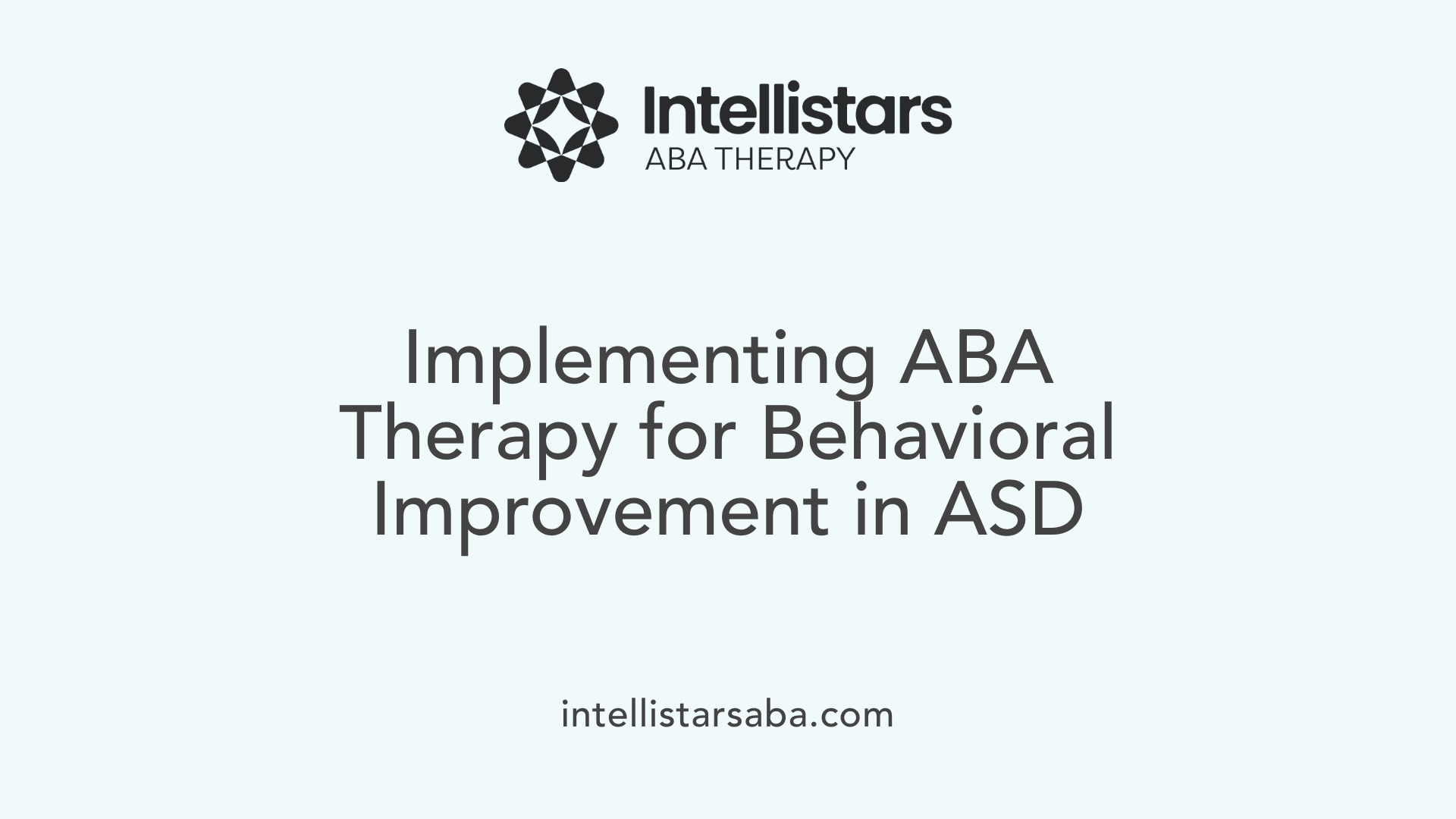
What is Applied Behavior Analysis (ABA) therapy?
Applied Behavior Analysis (ABA) therapy is a scientifically grounded method focused on understanding and changing behavior by carefully examining the environment, antecedents, and consequences. By analyzing these factors, ABA identifies patterns and uses targeted strategies to promote beneficial behaviors and decrease those that may pose difficulties.
Behavioral Analysis Basis
ABA operates on the principles of behavioral science, closely studying how behaviors develop and are maintained. This approach relies heavily on the concept of reinforcement—especially positive reinforcement—to encourage desirable actions. By rewarding behaviors such as communication, social interaction, and daily living skills, ABA helps individuals acquire new skills and reduce challenging behaviors.
Positive Reinforcement Techniques
One of the central techniques in ABA is the consistent use of positive reinforcement. When a helpful behavior occurs, something favorable is provided, increasing the likelihood that the behavior will continue. This could involve verbal praise, tokens, or tangible rewards. Therapists use structured methods like Discrete Trial Training, where tasks are broken down into small steps, and naturalistic teaching, which occurs during everyday interactions. These techniques make learning engaging and effective.
Its Role in Autism Treatment
ABA therapy plays a crucial role in treating autism spectrum disorder by tailoring individualized programs suited to each person's needs. It is implemented across various settings—homes, schools, or communities—to foster independence and skill development. Endorsed by reputable organizations and supported by extensive research, ABA remains one of the most effective behavioral treatments for autism. Its focus on positive, evidence-based interventions offers meaningful improvements in behavior and quality of life for individuals with ASD.
ABA Therapy Providers: Qualifications and Expertise

Who provides ABA therapy and what qualifications do they have?
ABA therapy is delivered by a team of dedicated professionals with specialized training to ensure effective treatment for individuals with autism spectrum disorder (ASD). The primary providers include Board Certified Behavior Analysts (BCBAs), Registered Behavior Technicians (RBTs), licensed therapists, psychologists, and special educators.
Board Certified Behavior Analysts (BCBAs)
BCBAs are often considered the gold standard in ABA therapy. They typically hold at least a master's degree in behavior analysis, psychology, education, or a related field. To earn BCBA certification, they must complete between 1,500 to 2,000 hours of supervised practical fieldwork, demonstrating competence in assessment, intervention planning, and ethical practice. Following this, candidates pass the rigorous BCBA certification examination.
Registered Behavior Technicians (RBTs)
RBTs provide direct ABA therapy under the supervision of BCBAs. They usually hold a minimum of a high school diploma or equivalent and must complete specialized training focused on behavior-analytic techniques. Certification for RBTs involves passing a competency-based assessment that evaluates their skills in implementing ABA interventions effectively.
Licensed Therapists and Psychologists
Licensed therapists and psychologists involved in ABA therapy typically have advanced degrees and clinical training in behavioral health or developmental disorders. Their licensure requires meeting state-specific education, experience, and examination criteria, along with maintaining continuing education to stay current with best practices. These professionals often play a vital role in comprehensive assessments and integrating ABA strategies within broader therapeutic plans.
Training and Certification Requirements
All providers involved in ABA therapy engage in ongoing education and supervision to maintain their credentials and ensure fidelity to evidence-based interventions. Training emphasizes understanding behavioral principles, data collection, individualized program development, and ethical standards to maximize treatment effectiveness.
This robust system of qualifications and expertise across different roles guarantees that individuals receiving ABA therapy benefit from skilled, knowledgeable practitioners dedicated to improving behavioral outcomes.
Benefits of ABA Therapy for Individuals with Autism
How does ABA therapy benefit individuals with autism?
Applied Behavior Analysis (ABA) therapy offers significant benefits for individuals with autism by focusing on skill development, enhancing communication and social interaction, reducing challenging behaviors, and ultimately improving quality of life.
ABA therapy systematically teaches essential skills such as communication, self-care, social interactions, and academic abilities. This comprehensive skill-building encourages greater independence and daily functioning for individuals with ASD. The approach is rooted in scientific methods, employing positive reinforcement to encourage desirable behaviors and analyzing behavior triggers through the Antecedent-Behavior-Consequence (A-B-C) model to understand and modify behaviors effectively.
Early, intensive ABA interventions tend to produce the most substantial developmental gains. For example, language acquisition and social skills greatly improve when therapy begins during early childhood. Individualized treatment plans often include structured techniques such as Discrete Trial Training (DTT) or more naturalistic teaching approaches, all tailored to meet the unique needs of each individual.
ABA therapy is delivered by trained professionals like Board Certified Behavior Analysts (BCBAs), ensuring the interventions are personalized and evidence-based. Besides fostering foundational skills, ABA also aims to decrease behaviors that interfere with learning or social engagement, such as self-injury or aggression.
By promoting functional and socially relevant behaviors, ABA enables individuals with autism to participate more fully in their communities and everyday life. The therapy’s positive impact spans across developmental domains, improving social communication, reducing disruptive behaviors, and enhancing overall well-being.
The lasting benefits of ABA highlight its role as a cornerstone in autism treatment, striving to maximize the potential and quality of life for those on the spectrum.
Target Behaviors and Skills Addressed by ABA Therapy
What types of behaviors or skills can ABA therapy target?
ABA (Applied Behavior Analysis) therapy is a versatile intervention that targets a broad spectrum of behaviors and skills essential for individuals, particularly children with autism spectrum disorder (ASD). The therapy's goal is to both enhance adaptive behaviors and reduce behaviors that may interfere with learning or social interaction.
Social, Communication, Academic, and Motor Skills
ABA therapy supports social skill development, such as turn-taking, sharing, understanding social cues, and building relationships. Communication skills, including verbal speech, sign language, and alternative communication methods like picture exchange systems, are critical targets. Academic skills can also be addressed, covering areas like reading, writing, and numeracy tailored to individual levels. Fine and gross motor skills, essential for tasks such as handwriting or coordination, are incorporated into treatment plans when necessary.
Daily Living Activities
Essential daily living activities like hygiene (e.g., toothbrushing, handwashing), grooming (e.g., dressing, hair care), and feeding are targeted to promote independence and self-care. Mastery of these skills enhances overall quality of life and enables greater participation in social and community settings.
Vocational and Independence Skills
ABA therapy extends to vocational training and fostering independence in various environments. Skills such as following schedules, managing tasks, operating simple machines, and navigating public transportation can be taught. These goals prepare individuals to transition successfully into adult life and employment opportunities.
Structured and Naturalistic Teaching Strategies
Interventions within ABA therapy employ structured teaching methods, which utilize discrete trial training focusing on clear instruction and reinforcement. Naturalistic teaching approaches complement this by embedding learning opportunities in everyday environments and routines, encouraging spontaneous use of skills.
In summary, ABA therapy is a highly individualized and evidence-based approach designed to improve a wide range of functional behaviors and skills essential for daily living, learning, and social integration.
Typical ABA Therapy Process and Intervention Strategies
What is the typical process or approach used in ABA therapy?
The typical approach used in Applied Behavior Analysis (ABA) therapy starts with a thorough assessment of the individual's current behaviors and skill levels. This initial evaluation is essential to identify specific areas that require intervention, such as social communication, daily living skills, or problem behaviors. Based on this assessment, therapists collaborate with families to set personalized, achievable goals tailored to the individual's needs.
Assessment and Goal Setting
Assessment forms the foundation for ABA therapy by pinpointing strengths and challenges through direct observation, interviews, and standardized tools. Goals are then designed to enhance functional skills and reduce behaviors that may interfere with learning or social interaction.
Positive Reinforcement and Prompting
ABA relies heavily on positive reinforcement to encourage desired behaviors. When an individual demonstrates the targeted behavior, it is immediately reinforced with rewards like verbal praise, tokens, or preferred activities. Prompting guides the individual to perform the behavior, gradually fading as independence improves.
Behavior Chaining and Modeling
To teach complex tasks, behavior chaining breaks skills into smaller steps, each learned sequentially to form the complete behavior. Modeling involves demonstrating desired behaviors clearly, allowing individuals to imitate and learn effectively.
Data Collection and Family Involvement
Consistent data collection during sessions monitors progress and guides modifications in intervention strategies. Family involvement is vital; caregivers receive training to reinforce skills across settings, ensuring generalization and maintenance of behaviors. Respecting cultural contexts also enhances the therapy’s impact.
Together, these strategies create a structured yet flexible approach that adapts to the unique profiles of individuals with autism, promoting meaningful and lasting behavioral improvements.
Linking Immune Dysregulation to Behavioral Therapies in Autism
How Is Immune Dysregulation Involved in the Etiology of ASD?
Research increasingly supports the role of immune dysfunction and inflammation in the development of Autism Spectrum Disorder (ASD). Elevated levels of pro-inflammatory cytokines such as IL-6, IL-1β, IL-18, and TNF-α have been observed in children with ASD, reflecting persistent neuroinflammation and immune activation. Genetic variants related to immune response (e.g., TSC1/TSC2) and chronic microglial activation further suggest that immune abnormalities contribute to ASD pathogenesis. Additionally, maternal immune activation during pregnancy is linked to increased ASD risk in offspring, implying early-life immune dysregulation effects.
How Does Immune Dysfunction Affect Behavioral Symptoms in ASD?
Chronic neuroinflammation mediated by activated microglia and inflammatory cytokines can influence neurodevelopment, potentially exacerbating autistic behaviors. For instance, imbalance in cytokines like decreased IL-7 (a protective factor) and increased pro-inflammatory markers (e.g., SULT1A1, CD244) correlates with higher ASD risk and behavioral abnormalities. Oxidative stress and disruptions in lipid and tryptophan metabolism further contribute to neuroimmune-mediated behavioral impairments observed in ASD patients.
Can Immune Pathways Be Integrated into Behavioral Therapies?
Given the involvement of inflammation in ASD, targeting immune pathways offers a promising complement to behavioral therapies. Treatments modulating inflammatory signaling—such as vitamin D supplementation, which decreases TNF-α and IL-37 levels and improves behavior—demonstrate potential benefits. Other immunomodulatory approaches include corticosteroids, IVIg, IL-6 inhibitors (tocilizumab), inflammasome blockers (anakinra), and mTOR inhibitors. Personalizing therapy based on immune profiles is critical because of ASD's heterogeneity. This integrative strategy could optimize behavioral interventions by reducing neuroinflammation and improving neurological outcomes.
What Are the Future Directions for Research?
Future research aims to characterize ASD subgroups through immune signatures to facilitate individualized therapies. Investigations into molecular pathways like NF-κB and microbiota-gut-brain interactions are expanding, with growing interest in microbiome-targeted interventions. Larger clinical trials are needed to validate immunomodulatory treatments and explore their direct impact on behavioral symptoms. Advancing understanding of immune-behavior connections will help develop comprehensive therapeutic frameworks combining immunological and behavioral approaches for ASD.
Personalizing Autism Treatment: Considering Immune Profiles and Inflammation
Why is heterogeneity important in ASD treatment?
Autism Spectrum Disorder (ASD) is characterized by significant heterogeneity, meaning symptoms and underlying biological features vary widely among individuals. This diversity extends to immune system profiles and inflammation levels, which appear to play important roles in ASD's pathology. Recognizing this heterogeneity is crucial for developing effective, individualized treatment plans.
How can immune biomarkers help subtype ASD?
Recent studies have identified a range of immune biomarkers linked to ASD, including pro-inflammatory cytokines such as IL-6, TNF-α, and IL-1β, as well as anti-inflammatory markers like IL-37. Additionally, molecules such as matrix metalloproteinase-10 (MMP10), caspase 8 (CASP8), and sulfotransferase 1A1 (SULT1A1) offer insights into the immune status of patients. These biomarkers can be used to classify ASD into subgroups based on inflammatory activity or immune dysfunction. This subtyping enables clinicians to predict which patients might benefit from certain immune-modulating therapies.
How can therapies be tailored based on immune profiles?
Treatment personalization incorporates immune biomarkers to tailor interventions such as Applied Behavior Analysis (ABA) alongside anti-inflammatory or immunomodulatory approaches. For example, individuals exhibiting elevated pro-inflammatory cytokines may benefit from therapies targeting specific inflammatory pathways, including IL-6 blockers or inflammasome inhibitors. Conversely, patients showing different immune signatures might respond better to nutraceutical supplements with antioxidant and anti-inflammatory properties or even gut microbiome interventions. Personalized selection of pharmacological agents like mTOR inhibitors or JAK/Th17 pathway inhibitors depends heavily on detailed immune profiling.
Why is patient selection critical in personalized ASD treatment?
Given the complexity and variability of immune dysfunction in ASD, patient selection is vital to maximize therapeutic efficacy and minimize risks. Not all individuals with ASD exhibit the same immune abnormalities, so indiscriminate use of immune-targeting therapies can be ineffective or harmful. Thorough assessment of inflammatory markers, genetic predispositions, and clinical symptoms ensures that treatments are matched to the individual’s unique immunological and neurodevelopmental profile.
Personalized medicine in ASD holds promise for improving outcomes by integrating immune biomarker data to guide therapy choices. Ongoing research continues to clarify these complex relationships and optimize individualized care strategies.
The Future Landscape: Integrating Immunology and Behavioral Science in ASD Intervention
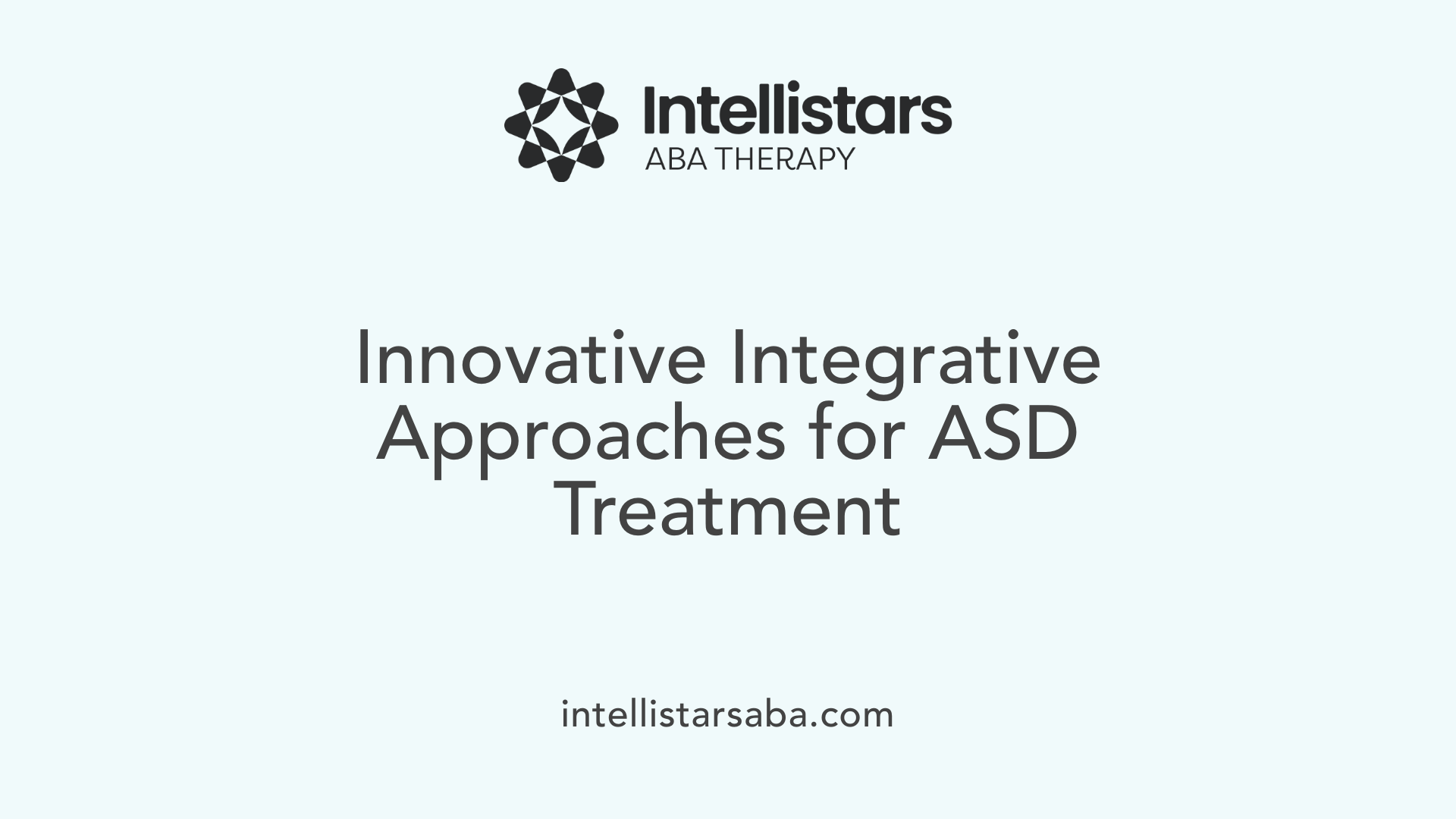
How Could Immune Signatures Improve ASD Diagnosis?
Emerging research points to distinct immune signatures in individuals with Autism Spectrum Disorder (ASD), including elevated inflammatory cytokines like IL-6 and TNF-α, and marked microglial activation in the brain. These immune profiles could serve as valuable biomarkers to identify ASD subtypes. Detecting such immune dysregulation early may refine diagnosis and enable personalized treatment plans that address both neurological and immunological factors.
What Are the Prospects for Combining Immunotherapy and Behavioral Therapy?
The integration of immunomodulatory treatments with conventional behavioral therapies represents a promising frontier. For example, therapies targeting inflammatory pathways—such as IL-6 blockade with tocilizumab or inflammasome inhibitors—might reduce neuroinflammation, thereby enhancing cognitive and behavioral intervention outcomes. Nutraceutical approaches combining antioxidants and anti-inflammatory compounds also hold potential to attenuate neuroinflammatory impacts in ASD.
What Advances Are Being Made in Research and Clinical Trials?
Significant strides have been made in clinical trials exploring immune-based interventions. Vitamin D supplementation, shown to reduce pro-inflammatory cytokines and improve behavioral scores, exemplifies modulating immune responses to benefit ASD symptoms. Investigations into biologics, small molecule inhibitors affecting pathways like NF-κB and PI3K/Akt/mTOR, and fecal microbiota transplants are ongoing. These studies reflect the growing multidisciplinary focus combining neuroimmunology and behavioral science.
Why Is There Hope for Improved Outcomes?
By acknowledging the role of immune dysfunction in ASD’s pathogenesis, treatment strategies are shifting toward more holistic models. Personalized therapies that address individual immune profiles alongside behavioral needs promise to optimize efficacy. As research progressively uncovers underlying molecular and genetic contributors to inflammation-driven ASD, targeted interventions stand to improve quality of life and functional outcomes for many affected individuals.
Towards Integrated Understanding and Therapy for Autism
The growing body of research underscores neuroinflammation and immune dysregulation as fundamental components in the etiology and progression of Autism Spectrum Disorder. From prenatal influences such as maternal immune activation to complex interactions involving the gut-brain axis and molecular inflammatory pathways, inflammation shapes the neurodevelopmental landscape associated with ASD. Behavioral interventions like Applied Behavior Analysis remain central to improving skills and quality of life, yet emerging insights advocate for integrative approaches that consider immune profiles and use anti-inflammatory strategies. Personalized treatment paradigms incorporating immunomodulatory therapies alongside behavioral science may hold the key to more effective management of ASD in the future, ultimately enhancing outcomes for individuals and families affected by autism.
References
- Research trends of inflammation in autism spectrum ...
- Effect of vitamin D supplementation on inflammatory status ...
- Interactions between circulating inflammatory factors and ...
- Autism spectrum disorder and a possible role of anti- ...
- Nutraceutical approaches for Autism Spectrum Disorder ...
- Inflammatory mediators drive neuroinflammation in autism ...
- Innate Immune Dysfunction and Neuroinflammation in ...
- Applied Behavior Analysis (ABA)
- How ABA Therapy Works: Breaking Down the Process
- Applied Behavior Analysis (ABA)






